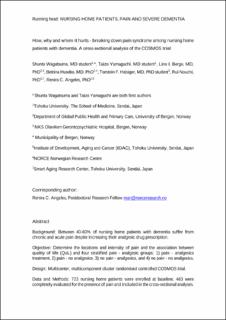| dc.contributor.author | Wagatsuma, Shunta | |
| dc.contributor.author | Yamaguchi, Taizo | |
| dc.contributor.author | Berge, Line Iden | |
| dc.contributor.author | Husebø, Bettina Elisabeth Franziska | |
| dc.contributor.author | Habiger, Torstein Frugård | |
| dc.contributor.author | Nouchi, Rui | |
| dc.contributor.author | Angeles, Renira Corinne | |
| dc.date.accessioned | 2022-06-27T08:15:58Z | |
| dc.date.available | 2022-06-27T08:15:58Z | |
| dc.date.created | 2021-04-07T16:29:46Z | |
| dc.date.issued | 2021 | |
| dc.identifier.citation | Pain Management Nursing. 2021, 22 (3), 319-326. | en_US |
| dc.identifier.issn | 1524-9042 | |
| dc.identifier.uri | https://hdl.handle.net/11250/3001001 | |
| dc.description.abstract | Background Between 40%-60% of nursing home patients with dementia suffer from chronic and acute pain despite increasing their analgesic drug prescription. Aims Determine the locations and intensity of pain and the association between quality of life (QoL) and four stratified pain–analgesic groups: (1) pain—analgesics treatment; (2) pain—no analgesics; (3) no pain—analgesics treatment; and (4) no pain—no analgesics. Design Multicenter, multicomponent cluster randomized controlled Communication, Systematic assessment and treatment of pain, Medication review, Occupational therapy, and Safety - an effectiveness (COSMOS) trial. Participants At baseline, 723 nursing home patients were enrolled; 463 were completely evaluated for the presence of pain and included in the cross-sectional analyses. Methods Data were collected using the following tests: Cognitive function (Mini-Mental-State Evaluation [MMSE]); Quality of Life in Late stage of Dementia (QUALID); Dementia-Specific QoL (QUALIDEM); Mobilization–Observation–Behavior–Intensity–Dementia Pain Scale (MOBID-2); and number of analgesic drug prescriptions. Analysis of covariance (ANCOVA) was used to compare pain and QoL across pain–analgesics groups. Results The majority of participants (78%) had moderate-to-severe dementia, were female (74%), and a mean age of 86.7 years. Almost 44% reported clinically significant pain, whereas 69% had ≥2 pain locations, especially in the musculoskeletal system. Some 33.5% of participants had pain receiving analgesics, 10% had pain with no analgesics, and 27% had no pain receiving analgesics. Patients evaluated with clinically significant pain intensity scores had lower QoL (<.001) compared with assessments relying on different pain locations. Conclusion Untreated musculoskeletal and multi-located pain is still common in nursing home patients with dementia. A significant share without pain receive analgesics. Proper pain assessment and regular re-assessment are prerequisites for the prescribing and deprescribing of analgesics. Pain intensity scores are more significantly connected to QoL. This must be stressed when evaluating pain and QoL. | en_US |
| dc.language.iso | eng | en_US |
| dc.title | How, Why and Where it Hurts—Breaking Down Pain Syndrome Among Nursing Home Patients With Dementia: A Cross-Sectional Analysis of the COSMOS Trial | en_US |
| dc.type | Peer reviewed | en_US |
| dc.type | Journal article | en_US |
| dc.description.version | submittedVersion | en_US |
| cristin.ispublished | true | |
| cristin.fulltext | original | |
| cristin.fulltext | preprint | |
| cristin.qualitycode | 1 | |
| dc.identifier.doi | 10.1016/j.pmn.2020.11.014 | |
| dc.identifier.cristin | 1902809 | |
| dc.source.journal | Pain Management Nursing | en_US |
| dc.source.volume | 22 | en_US |
| dc.source.issue | 3 | en_US |
| dc.source.pagenumber | 319-326 | en_US |
